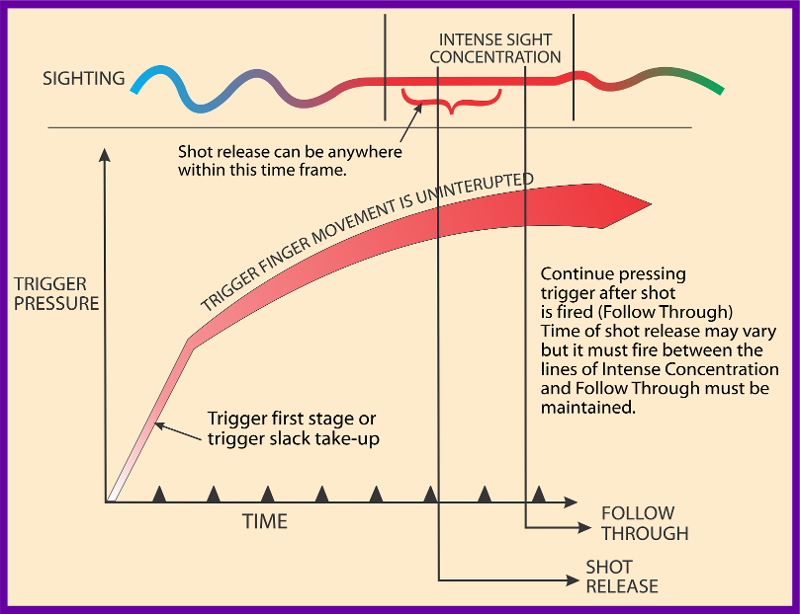
Trigger control or the lack of!
With a lot of emphasis on stance/position and alignment to the centre of the target, coupled with grip alignment, it is easy to see that focus of attention is shifting somewhat to trigger control. We know that perfect sight alignment is very difficult but we teach newer and not so newer shooters to “accept” the “wobble” area and strive for good sight alignment (as best they can) and continue pressing the trigger in a smooth, continuous manner, directly to the rear.
It is regarded that the initial trigger pressure should be taken up at the bench prior to the uplift. So the arm is out stretched with the muzzle still in contact with the bench, wrist and elbow locked and the shooter feels the trigger shoe, either taking up the first stage, slack, or finger pad pressure. The initial trigger take up can also be applied at the top of the lift, here a personal preference is in order.
When lifting the pistol and entering the target area, it must be ensured that the sights enter the holding area through the centre of the black, through the ten ring. As the sights appear under the black and in the shooters area of hold, the trigger is pressed in a controlled manner as described, whist striving for good sight alignment and stability through stance and grip etc.
The shooter should not be concerned too much about the area of hold or “wobble” but focus attention to the smooth, continuous pressing of the trigger.
As a newer shooter, it may take several years to achieve a “good hold” or small “area of hold” so focus should be on the application of the trigger finger pressing in a controlled manner. This needs to be done for each shot to learn the process of smooth, directly to the rear press, without disturbing the sights. This can be learnt through dry fire and other exercises.
We know that a slightly misaligned sight will divert the shot from the centre of the target……. that's fact. But what seems to happen to newer and not so newer shooters is that when the sights seem to be in alignment, or best that they can, they quickly fire the shot, which is done with a fast trigger movement and the displaced shot is worse than expected due to the fast, uncontrolled trigger finger movement, disturbing the sights even more.
With time and correct training, the shooter should develop a situation whereby the shot appears to fire of its own accord as the sights settle into their area of aim. This is usually called a “surprise” shot or a “sub-conscious” shot release but some may call it a reflex action where things “just happen”. This may take several years of diligent training to gain this experience and some may never experience this phenomenon!
To state it should be a sub-conscious press is justified to an extent but the initial trigger activation and press (or preload) must be done consciously. In taking up the first stage, we have activated the trigger “consciously” to start the process. As the pistol settles into the area of hold under the black, a continued pressure is applied whist striving for correct sight alignment. The training exercises should be such so that it is a conscious effort to apply trigger pressure whilst aiming.

Make a free website with Yola
